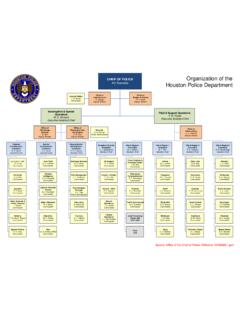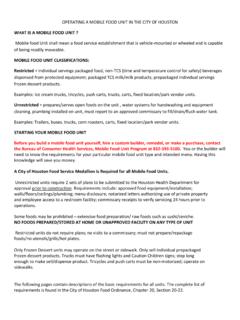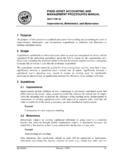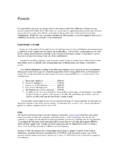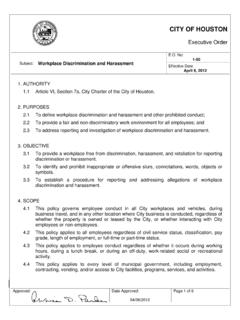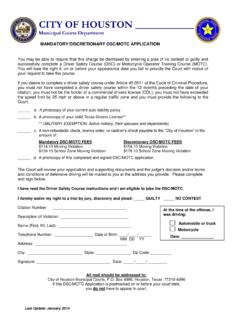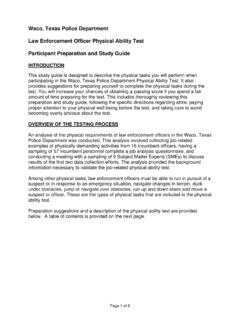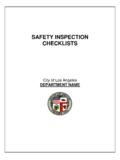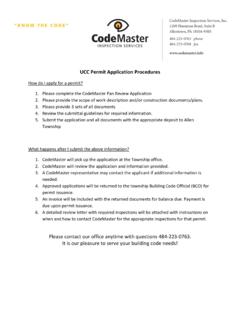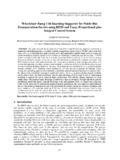Transcription of Physical Ability Test - Houston
1 Firefighter Physical Ability Test Candidate Orientation guide Houston Fire Department Copyright 2014, Selection Works, LLC 1 Physical Ability Test Candidate Orientation guide his manual has been developed to introduce you to the Houston Firefighter Physical Ability Test (PAT). The test consists of two separate components. The first component is a series of tasks designed to assess important Physical abilities necessary for effective job performance as a firefighter. The second component is a mile run. The following section describes both components of the Physical Ability test and offers information to assist you in preparing. Component 1: Job Simulation Tasks The first component of the test contains five job-simulation events that will be timed in a continuous series. These events include: Ladder raise Stair climb with equipment Hoseline hoist Equipment carry Victim Rescue (dummy drag) The following guidelines apply to this component of the PAT.
2 Applicants must wear a self-contained breathing apparatus (SCBA), excluding the face piece and low-pressure hose, for all elements of the job simulation component. The SCBA weighs approximately 20 pounds. Applicants are strongly encouraged to wear athletic shoes (sneakers) and appropriate clothing for physically demanding work. You will be performing Physical acts that demonstrate strength, agility, and endurance, and it is important to be outfitted in attire that does not hinder your performance. During the PAT, you may get dirty and/or wet from maneuvering through the exercises. Plan your dress accordingly. Protective gloves are optional and it is the candidate s choice whether or not to use gloves. You may bring your own gloves, kneepads, etc. to use; however, the testing authority reserves the right to inspect all equipment, and to disallow equipment, to ensure that its use does not affect the fair and impartial administration of the PAT.
3 All five elements of this component of the PAT will be timed in a series. The test has a cutoff time and failure to complete the course in the allowed time will result in disqualification. You must not run during the test. Running is not permitted on a working fireground, and it will not be allowed during this test. Failure to heed a first warning not to run may result in disqualification. Running is defined as any time both feet are off the ground at the same time while you are advancing on the course. You may move as fast as you like, while remaining safe, on the stair climb stations as it is not technically possible to run during these components. T Copyright 2014, Selection Works, LLC 2 You should hit every stair going up and coming down while climbing the stairs. You may move as quickly as you like and are encouraged to use the hand rails as needed. Test monitors will be assigned to time you while on the course.
4 It is acceptable to ask the test monitor questions concerning course rules and layout prior to beginning the course and while on the course. You will be allowed as much time as needed to complete each individual component of the PAT within the maximum allotted time. Should you perform one of the components incorrectly, the test monitor will guide you as to how to correct your actions or to perform the component again. Pay careful attention to the instruction of the test monitor and ask for clarification when needed. Unnecessarily dropping, throwing or other intentional misuse of any of the testing props will be grounds to disqualify a candidate. The following pages provide a description and preparation information regarding each of the five events contained in the first component of the PAT. PLEASE NOTE THAT SUGGESTIONS REGARDING PREPARATION ACTIVITIES ARE SIMPLY SUGGESTIONS INTENDED TO OFFER THE CANDIDATE A MEANS OF PRACTICING FOR THE PAT.
5 THESE ARE ONLY SUGGESTIONS. THE Houston FIRE DEPARTMENT AND THE PAT DEVELOPER CANNOT BE HELD RESPONSIBLE FOR INJURIES OR EXPENSES INCURRED DURING PREPARATION FOR THE PAT. Copyright 2014, Selection Works, LLC 3 #1: Ladder Raise Station Description: The candidate will raise the fly section of a 24-foot extension ladder using the rope (halyard). The ladder is secured to the rails of the tower staircase. The candidate will use a hand-over-hand technique to extend the fly section of the ladder until the ladder is fully extended. The candidate will then lower the fly section down using a hand-under-hand technique. If the candidate loses control of the halyard ( , the rope slips through hands), he/she will be required to perform the event again. While raising and lowering the ladder, the candidate s feet must remain in a 3-foot by 3-foot box that is painted on the ground. Preparation: To simulate the ladder raise exercise, you can tie a rope securely to a weighted bag and place the rope over a sturdy horizontal bar that is eight to ten feet above the ground.
6 Then you can use the same movements as you would in the ladder raise to bring the weight to the top of the bar and slowly lower it back to the ground. PLEASE NOTE THAT SUGGESTIONS REGARDING PREPARATION ACTIVITIES ARE SIMPLY SUGGESTIONS INTENDED TO OFFER THE CANDIDATE A MEANS OF PRACTICING FOR THE PAT. THESE ARE ONLY SUGGESTIONS. THE Houston FIRE DEPARTMENT AND THE PAT DEVELOPER CANNOT BE HELD RESPONSIBLE FOR INJURIES OR EXPENSES INCURRED DURING PREPARATION FOR THE PAT. Copyright 2014, Selection Works, LLC 4 #2: Stair Climb Station Description: The candidate will climb up to and back down from the 7th floor of the training tower (6 flights of stairs) while carrying a bundled section of 2 -inch hoseline that weighs 35 pounds. Before entering the tower, the candidate will pick up the bundled hosepack. The candidate must carry this hosepack without dragging it.
7 The candidate should hit every stair going up and coming back down the staircase. When the candidate reaches the 7th floor, he/she will place his/her feet on the landing and then turn around and descend the stairs. The candidate may use the hand rails and may move as fast as he/she chooses on the stairs. Once the candidate exits the tower, he/she should set the hosepack on the ground. Preparation: This station assesses muscular and cardiovascular endurance. You may practice for this station by ascending and descending stairs while carrying approximately 55 pounds of weight (SCBA plus hose pack). PLEASE NOTE THAT SUGGESTIONS REGARDING PREPARATION ACTIVITIES ARE SIMPLY SUGGESTIONS INTENDED TO OFFER THE CANDIDATE A MEANS OF PRACTICING FOR THE PAT. THESE ARE ONLY SUGGESTIONS. THE Houston FIRE DEPARTMENT AND THE PAT DEVELOPER CANNOT BE HELD RESPONSIBLE FOR INJURIES OR EXPENSES INCURRED DURING PREPARATION FOR THE PAT.
8 Copyright 2014, Selection Works, LLC 5 #3: Hose Hoist Station Description: The candidate will ascend to the third floor of an outdoor staircase, use a rope to hoist a rolled-up section of hoseline up to and back down from the third floor, and then descend the staircase. If the candidate loses control of the rope ( , the rope slips through hands), he/she will be required to perform the event again. While raising and lowering the hose roll, the candidate s feet must remain in a box that is painted on the ground on the 3rd floor landing. Preparation: To simulate the hose hoist, you can tie a rope securely to a weighted bag and place the rope over a sturdy horizontal bar that is eight to ten feet above the ground. Then you can use the same movements as you would to reel in a load attached to the rope. The weight of the hoseline is approximately 35 pounds. PLEASE NOTE THAT SUGGESTIONS REGARDING PREPARATION ACTIVITIES ARE SIMPLY SUGGESTIONS INTENDED TO OFFER THE CANDIDATE A MEANS OF PRACTICING FOR THE PAT.
9 THESE ARE ONLY SUGGESTIONS. THE Houston FIRE DEPARTMENT AND THE PAT DEVELOPER CANNOT BE HELD RESPONSIBLE FOR INJURIES OR EXPENSES INCURRED DURING PREPARATION FOR THE PAT. Copyright 2014, Selection Works, LLC 6 #4: Equipment Carry Station Description: The candidate will carry a box weighing 75 pounds for a distance of 100 feet. The candidate will pick up the box off a 2-foot platform, carry the box for 50 feet around a cone and back to the starting location, and place the box on top of a 3-foot platform. The weighted box simulates the weight of a hydraulic power plant. You may set the box down at any time to rest, but may not drag or push the box it must be carried. Preparation: This station assesses core body strength, grip strength and overall cardiovascular endurance. You may prepare for this event by carrying a 75 pound object for a distance of 100 feet. PLEASE NOTE THAT SUGGESTIONS REGARDING PREPARATION ACTIVITIES ARE SIMPLY SUGGESTIONS INTENDED TO OFFER THE CANDIDATE A MEANS OF PRACTICING FOR THE PAT.
10 THESE ARE ONLY SUGGESTIONS. THE Houston FIRE DEPARTMENT AND THE PAT DEVELOPER CANNOT BE HELD RESPONSIBLE FOR INJURIES OR EXPENSES INCURRED DURING PREPARATION FOR THE PAT. Copyright 2014, Selection Works, LLC 7 #5: Victim Rescue (Dummy Drag) Station Description: The candidate will drag a human form dummy weighing 165 pounds (weight of dummy and clothing) for 25 feet, around a barrel/cone and then back across the starting point for a total distance of 50 feet. The candidate will drag the dummy using the pull harness attached to the dummy or by placing his/her elbows under the armpits of the dummy. In order to complete this station, the candidate and the dummy must both completely cross the finish line. Preparation: This station assesses lower body strength and endurance. You may prepare for this event by dragging a weighted object using a rope. PLEASE NOTE THAT SUGGESTIONS REGARDING PREPARATION ACTIVITIES ARE SIMPLY SUGGESTIONS INTENDED TO OFFER THE CANDIDATE A MEANS OF PRACTICING FOR THE PAT.
